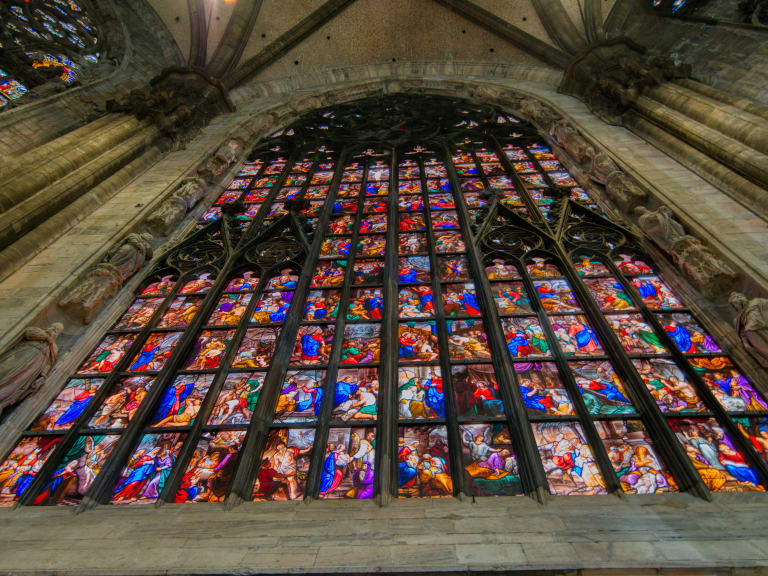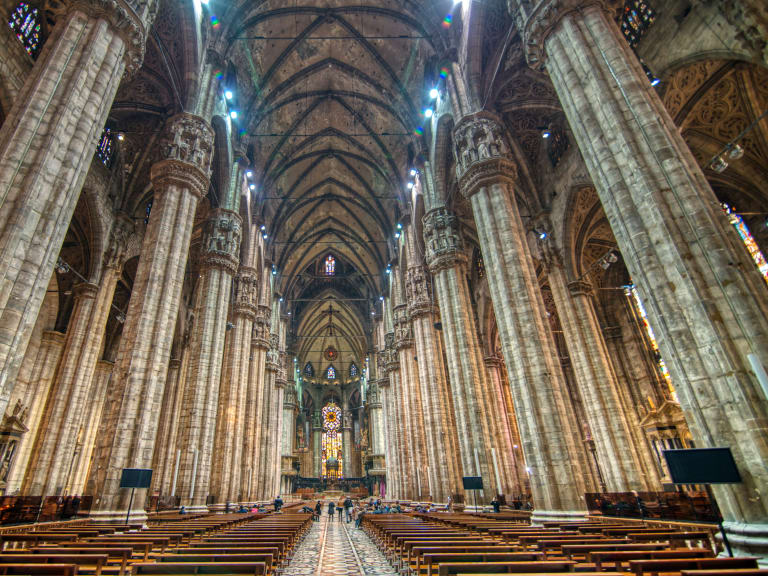More about: Things You Can´t Miss at Duomo Milan
The third largest Catholic church in the world is among the attractions to see in Milan. It took almost five centuries to build and in a way you could say it was never finished. The Veneranda Fabbrica del Duomo is still busy repairing the damage and replacing the damaged statues.
The Milanese cathedral is covered with a particular marble that is still quarried in Candoglia, on the shores of Lake Maggiore. This magnificent covering protects the jewels and curious details hidden inside. This article will serve as a guide for your walk in the Duomo.
1. Stand in awe beneath the monumental stained-glass windows

The cathedral dedicated to the Virgin Mary is decorated with more than 50 stained glass windows made by the masters of the time. These large skylights were of fundamental importance: they illuminate the Duomo and depict various scenes from the Holy Scriptures that anyone can understand, from the cultured to the most humble.
During the Middle Ages, light had a strong symbolic meaning: it was an expression of the divine and the counterpart of darkness, which was synonymous with sin. If the Romanesque style is characterised by silence and contemplation, Gothic art seeks an approach to God and pursues it with diaphanous atmospheres and architectures that touch the sky.
As you enter, take the time to walk under the large stained glass windows that portray lives of saints, biblical scenes and other anecdotes. If you visit Milan at Christmas time, the windows are illuminated from the inside creating a very evocative atmosphere.
2. Discover the history of the Holy Nail

Milan's cathedral houses a very precious relic: a nail of the Holy Cross. If you are wondering how it got to northern Italy, there are several theories. According to the most reputable one, it was found by St. Helena, mother of Emperor Constantine, during a journey to the Holy Land.
After the death of Constantine and his heirs, the nail found its way into the hands of Theodosius I the Great, after which its traces were lost. Fortunately, the future patron saint of the city, Sant'Ambrogio, found it a few years later in a farrier's workshop. Initially, the relic was kept in the now disappeared basilica of Santa Tecla.
Finally, it was moved inside the Duomo on 20 March 1461 and since then it has been kept in the highest point of the apse. If you visit Milan in September you can witness the rite of the Nivola, a ritual that picks up the nail from the apse to bring it closer to the ground. To perform it, the archbishop climbs a cloud-shaped structure dating from the 17th century.
This device is decorated with figures of angels and rises to a height of 40 metres. The ritual is usually performed on the religious feast of the Exaltation of the Holy Cross on 14 September.
3. Contemplate the paintings of San Carlo

Between the columns of the Cathedral a series of paintings, called "Quadroni", make a beautiful presence. They pay homage to the figure of San Carlo Borromeo, archbishop of the city in the 16th century.
He was animportant figure and is remembered for his frequent visits to all his dioceses and for having helped thousands of sick people during the plague epidemic of 1576.
The paintings illustrate the life and miracles of the saint: the administration of the sacraments to the sick, the meeting with the princes of Savoy in Turin, his funeral in the Duomo and other episodes.
Unfortunately they cannot be seen all year round: they are exhibited on 4 November, the feast day of St. Carlo Borromeo, and remain inside the cathedral for just under two months. If you visit Milan in January, the first half of the year, you will have time to see them.
San Carlo was originally from Arona, a village on Lake Maggiore. Arona is not only known for the huge statue portraying him, but also for its beautiful lakeside promenade overlooking the Rocca di Angera, a fortress on the opposite shore. Keep it in mind if you are looking for tours and excursions from Milan.
4. Find the Sack of the Last Judgement

As you enter the cathedral, head towards the first right-hand bay and look up. You will see a large burlap cloth hanging from the ceiling.
No one knows what it contains and it is said that it will only fall when the end of the world comes. Nor is it known how it ended up at the end of the cathedral...
5. Take a close look at the statue of Saint Bartholomew Flayed

Saint Bartholomew was one of the twelve apostles and was flayed alive for not having renounced the Christian faith. A statue commemorates this episode and you can see it in one of the side entrances to the cathedral. In fact, it was originally in the square but was moved inside because it frightened the most sensitive people.
Don't be fooled, what at first glance looks like a tablecloth is actually her skin hanging from her shoulders. The removed complexion exposes the saint's muscles and sinews that stand out for their anatomical precision.
6. Look for the Sundial

Entering the Milan Cathedral, with a little attention you will see a metallic line on the floor that crosses the five naves and goes up a few metres on the left side. If you look closely, on the opposite wall there is a small hole about 24 metres high and with a diameter of about 2.5 centimetres. At midday, the sun streams through the hole, reaches the opposite wall and the light is projected onto the brass strip.
Thanks to this method, the Milanese were able to know the exact time, a very important element in a city that was experiencing a golden age. Indeed, the sundial was built under the reign of Joseph II of Habsburg who also introduced the illumination of the main streets with oil lights and the numbering of all buildings.
The Duomo's sundial is one of the most accurate in the world and its construction is due to the astronomers of the Brera observatory which still exists today and is complemented by a museum housing the scientists' old tools. As you can imagine, it is located next to Milan's famous Pinacoteca.
7. Stand in front of the monument of Gian Giacomo Medici

The Medici family is linked to Florence, but this member has nothing to do with them. Gian Giacomo was born in Milan at the end of the 15th century. As a young man he distinguished himself by some military exploits, especially against the Guelphs and the French. His successes led him to fight for the army of Charles I of Spain.
He was a great leader and, on his death in 1555, Pope Pius IV commissioned a funerary monument from the famous sculptor Leone Leoni. The figure of the soldier occupies the centre of the composition and is depicted with his left leg forward and partially covered by a cloak. On both sides are the allegories of Peace and Militia.
8. Learn about the history of the Baptistery of San Giovanni alle Fonti

In the year 378, the patron saint of the city, Saint Ambrose, ordered its construction to cope with the increase in population. It was inspired by imperial mausoleums, as Milan was at that time the capital of the Western Roman Empire.
It had eight sides and three steps led the faithful to the tub. You can see its remains in the basement of the Cathedral.
9. Admire the sarcophagus of Ottone Visconti

Ottone Visconti, nicknamed Ottorino, was a key figure in the history of Milan. His family competed with the Torriani family for control of the city and it was only after long years of struggle that Ottone became archbishop and handed over the reins of power to his grandson Matteo.
Thus began the Visconti dynasty that ruled over the Lombard capital for two long centuries.
After his death, his remains were placed in a sarcophagus supported by two red marble columns. Its structure is reminiscent of Roman porphyry funerary monuments and served as inspiration for the Ark of Berardo Maggi, another funerary monument preserved in the old cathedral of Brescia.
By the way, if you are interested in visiting Brescia or other locations in the Lombardy region, I recommend you to read the post about the best tours and excursions from Milan.
10. Organ of the Duomo

It is the largest pipe instrument in Italy and ranks in the top ten in the world. It is located on both sides of the presbytery and is very impressive but its main feature is its eclectic sound structure.
Moreover, in 2019 it was completely refurbished to continue to guarantee excellent sound quality. You can listen to it on mass days.
Bonus track: the Tarantasio dragon

Legend has it that around the year 1100, in the outskirts of Milan, there was a large lake where a terrifying creature lived: the dragon Tarantasio.
Nobody managed to defeat it until Umberto Visconti, the progenitor of the eponymous aristocratic family of the same name, tried to do so. A statue commemorates this legendary monster.
It is not inside the Duomo, but almost. You will see it to the right of the central door, near the marble frieze.
By the way, some people think that a dragon lives in Lago di Como. It is known as lariosauro and it is said to hide in caves under the water. To find out if this is myth or fact, just take a trip to Lago di Como from Milan.
Where to eat near Milan Cathedral

The Duomo and its square are the heart of the city. In the surrounding area there are thousands of dining options, from the cheapest to the most expensive.
As it is a very touristy area, it is important to know which establishments offer authentic Italian food and the best of international cuisine. The list below lists the recommended options:
- Maio Restaurant, where gastronomy and views embrace. It offers Italian cuisine with an eye for new trends. It also has a varied wine list (Piazza del Duomo - Centro Comercial La Rinascente, 7th floor).
- Ciciarà, a restaurant that follows the philosophy of "nouvelle cuisine antique". Translated, it reinterprets traditional dishes without distorting them. It is located near the Basilica of Santo Stefano Maggiore (Piazza Santo Stefano 8).
- Gino Sorbillo Lievito Madre, the pizzeria chain that is taking the country by storm. The progenitor Luigi Sorbillo opened his first restaurant in Naples in 1935 and year after year, the number of restaurants has multiplied both in Italy and abroad (Largo Corsia dei Servi 11).
- Savini Milano 1867, a classic in the Galleria Vittorio Emanuele. It is one of the oldest and most famous restaurants in the city and a meeting point for the Italian and international jet set (Via Ugo Foscolo 5 corner Galleria Vittorio Emanuele II, 1st floor).
- Temakinho, the fusion between Japan and South America. The establishment near the Duomo is located in Via Guglielmo Marconi 4, but if you like it and want to repeat, you will find more restaurants in the city.
For more ideas, I recommend you read the post about the 10 things to see and do in Milan's Duomo square.




